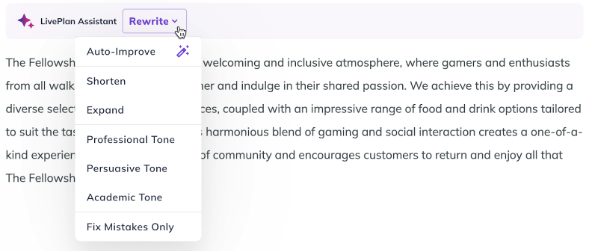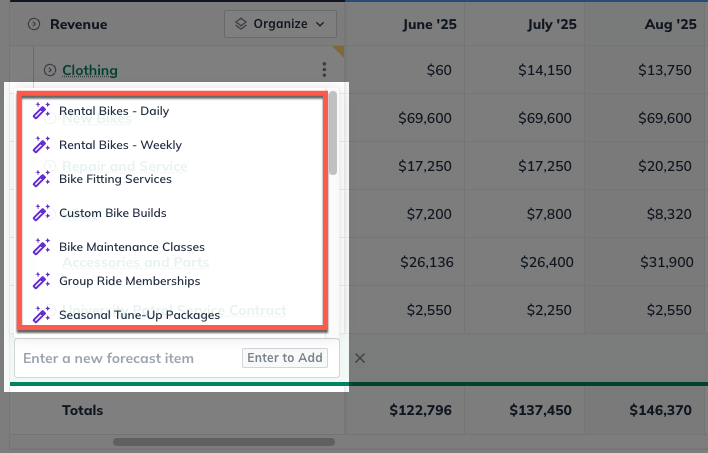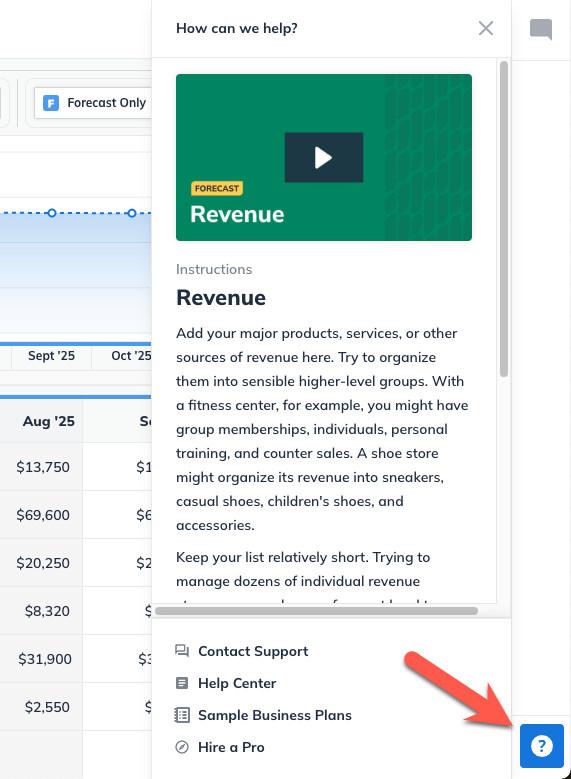Getting Started in LivePlan
Welcome to LivePlan! In this article we’ll dive into the program focusing mainly on the mindset and thought process behind creating a business plan in LivePlan. We know that planning for a business can feel overwhelming and learning a new program as well can add to that. However, having a clear understanding of how to approach your business plan in LivePlan will give you a huge foot up and help you make the most of LivePlan’s features.
Before getting started
It’s essential to start with a solid foundation even before getting into LivePlan. To make the most of your planning experience, it's helpful to have a few key things along with a prepared mindset:
A Business Idea:
Have a clear vision of what you want to achieve. Whether it's a new startup concept or an expansion of your existing business, having a well-defined idea will guide your planning process. Here are some key questions about your business idea to consider. These will help you clarify your goals and prepare you for the planning process:
Why are you starting a business? Understanding your motivation will help maintain the focus and drive through the planning process. Whether it's passion for a product, a market opportunity, or a desire for independence, knowing your 'why' is fundamental.
What are your strengths and weaknesses? Self-awareness is crucial in business. Identifying your strengths will help you leverage them and recognizing your weaknesses will help you address them and potentially seek help in those areas.
Have you considered the pros and cons? Every idea has its advantages and challenges. Weigh the potential benefits against the risks to ensure you’re making a well-informed decision.
Have you sought advice from the right people? Mentors, industry experts, and experienced entrepreneurs can provide valuable insights. Don’t hesitate to seek their advice and learn from their experiences.
Can you answer critical questions? Ensuring you can address essential questions about your business model, target market, funding needs and competitive advantages will help you be able to preemptively speak to those questions when writing your business plan.
2. Industry Research:
Understanding the market you're entering is crucial. Gather data about industry trends, competitors, and potential customers. This information will enlighten your strategies and help you make informed decisions. You can learn more on our free resource website Bplans here: How to do market research
3. Willingness to Learn:
No one has all the answers right away, and that's okay! Be ready to look up information and seek out resources to fill in any knowledge gaps as you go through the planning process. This proactive approach will serve you well as you develop your business plan. “Your first step should be understanding why you’re starting and what it will take to succeed.” (What to Do Before Starting a Business)
Starting a business is a significant step that requires careful planning and consideration. By addressing these preliminary steps and preparing yourself mentally, you'll be better equipped to create a robust and effective business plan with LivePlan.
Best Practices
Now that you have a clear vision for your business and what you need out of your plan we can get into the process of creating your plan in LivePlan. Here are some general best practices to keep in mind as you navigate through LivePlan and begin crafting your business plan.
Know Why You Are Writing a Business Plan
Understanding the purpose behind your business plan will influence your approach:
Internal Use: If you're writing a business plan for yourself or internal use, you can skip sections like team and organizational structure and focus on strategy and financials.
Raising Funds: If you're seeking investment, spend more time explaining why you're raising funds and how you'll use them. Investors will want detailed information about your business model, revenue projections, and growth strategy.
“Regardless of how you intend to use your business plan, think about why you are writing and what you’re trying to get out of the process before you begin.”
2. Start General, Then Get Specific
Start with broad concepts, estimated or average forecast figures, and getting a sense of the key information to address in the written plan. It’s easier to refine a general idea, or estimated figure, than to perfect a detailed plan from the start.
3. It Doesn’t Need to Be Perfect
Your first draft is just that—a draft. Don't worry about getting everything perfect on the first try. The goal is to get your ideas down on paper. LivePlan is designed to be a living document so that you can continue planning long after your startup date. As LivePlan’s founder says, “A mediocre plan well implemented is better than a brilliant plan that never gets implemented” (Tim Berry).
4. Experiment with the Program
As a living document LivePlan is designed to be flexible. Experiment with different features and sections to see what works best for you. Create a mock-up business plan to get comfortable with navigating the system and inputting data before getting serious with your real plan.
5. Use Your Resources Wisely
Take advantage of the resources available to you. Are you working with a SCORE mentor or Small Business Development Center (SBDC)? These organizations offer valuable guidance and support. Additionally, LivePlan offers support from our in office LivePlan experts who are available through chat Monday - Friday, 8am - 5pm PST. You can learn more here: Getting help with your plan
6. Don’t Be Afraid to Ask Questions
Remember, everyone starts as a beginner; it's okay not to know everything right away. Reach out for help when needed, and use the support resources available. Asking questions is a critical part of the learning process.
By keeping these practices in mind, you'll be able to approach your business planning with more confidence and clarity. Remember, the goal is to create a living document that evolves with your business and helps you navigate a path to success.
LivePlan Features to jumpstart your planning process
LivePlan offers several powerful features designed to simplify and enhance your business planning process. These tools can help you get started quickly and ensure your plan is comprehensive and well-organized.
The LivePlan Guide
Located in the Home section, the first section at the top of the left sidebar, LivePlan’s Guide is a recommended step by step approach to crafting your plan. Within the guide you can also track the progress of your plan as you, or your collaborators, finish sections of the plan. You can go one step at a time or start in the section where you have accumulated the most information; whatever method is most comfortable for you.
The Guide is there to help if you ever feel lost or need to keep track of where you are on your planning journey.

If you’d like to learn more about using Progress Indicators with the Guide you can find more details here: Using Progress Indicators in the Forecast
LivePlan AI Assistant
The LivePlan AI Assistant can help you quickly generate work for your plan:
In the Pitch:
When editing the Pitch you’ll see that certain sections have a Get Suggestions icon. Clicking this icon will have the LivePlan Assistant generate suggestions for that Pitch topic which you can input into the Pitch.

In the Plan:
When working in the Plan, you’ll see a Help Me Write icon when working in topics that do not yet have content in them. The Help Me Write function will allow you to use the LivePlan Assistant to generate work for that topic, based on your business description and any other information that you prompt the assistant with when generating the work.

If a topic already has content in it you’ll see a Rewrite tool instead. The Rewrite function will allow you to use the LivePlan Assistant to iterate on your plan content. It can be used to check for grammar, adjust tone, or even expand on the topic.

In the Forecast:
Similar to the Assistant’s functionality in the Pitch, you can find the LivePlan Assistant in the Forecast’s Financial Tables where you can use it to Get Suggestions for business revenue streams, direct costs, personnel, and expenses.

You can learn more about our AI tools here: LivePlan Assistant
Starting with a new business idea
If you’re planning for a startup endeavor or exploring a new business venture, LivePlan provides tools to help you brainstorm and organize your thoughts as you go through the initial planning process.
Pitch
The Pitch can be useful if you’re in the idea stage and are looking to get pin down the essential details of the business. Since the Pitch is a more condensed version of the Plan it allows you to focus on the foundational details at the core of your business. From there you can expand on those ideas in the Plan.
Plan
If you already have a good amount of data and detail about your business, starting with the Plan can be beneficial. Focus on the topics you are the most familiar with and use the LivePlan Assistant as needed to help with fleshing out your plan. As you learn more about your industry and the goals of the business shift you’ll want to update your plan accordingly. It is there to be your roadmap to success! So remember, you can always come back to edit and add more detail later.
Forecast
Early utilization of the Forecast will help give you a better understanding of your business’ financial landscape and potential. Starting with general figures in the forecast will allow you to get an overall sense of the industry. From there as you do further research for the plan you can hone the figures and focus in on the business’ specific financial projections.
Brainstorming for your business idea in LivePlan
Now that we have a solid idea of the tools within LivePlan and how they can be used, let’s go through an example workflow of how you might develop a business idea in LivePlan. Please note that this is one of many potential ways to develop a business plan using LivePlan and is purely to help get you thinking about how the elements of the planning process can work best for you and your specific business needs.
Start with the Pitch
Going through the process of crafting the Pitch first will allow you to outline the general goals of the business, define the business’ premise, and begin focusing on the things that will make your business stand out in its market. A fully fleshed out Pitch will also function as a jumping off point for creating the written Plan later.
Forecast your business’ generalized financials
Now that the Pitch has given you a solid direction for your business use the Forecast to start iterating on the financials behind running a business in your chosen industry. Entering approximated figures will allow you to get a sense of the predominant financial factors the business will deal with as you continue to research and develop your new endeavor. Here are a few questions to help foster this kind of Forecasting process: What type of financials come with a business in this industry?What profit do businesses of this type usually see in your area?What services or offerings will your business provide?What is the average price point for those offerings?
Deep dive into the written
Plan Now that you have a sense of the landscape of your industry and the goals you have for your business you can start getting specific about the business’ path to success. Through this process you’ll learn more about the specifics of your business and will be able to refine your forecast figures into precise projections aimed toward financial success. The focus of a business plan is not to produce a document that predicts the future of the company, it’s the process that’s important. Writing your plan, reviewing it, and adjusting as your business strategy changes will give you a clearer concept of what is needed to achieve your goals. The Plan is intended to be a living guide for your business that explains your business strategy and keeps you working toward your business goals. Use the Instructions at the top of the text editor to help guide your writing. The instructions will contain questions to help direct your writing and you can even use Custom Instructions to have our LivePlan Assistant generate instructions specific to your business idea and industry.
If you’re planning for a startup or investigating a new business idea this article from our resources website could be a good resource on your planning journey: Business Startup Checklist
Starting with an existing business
When crafting a plan for an existing business, the mindset shifts slightly. Since you already know the landscape of your business you can focus on using LivePlan as a management tool to track progress and keep your business aimed toward growth. Nothing ever goes exactly as planned, so having a living document will help keep the business on course even while dealing with unexpected challenges or pivoting toward new goals.
Key Benefits of Ongoing Planning
Revenue Forecasting: Continually projecting your business financials will help to establish clear sales goals and track your progress toward them. You can also forecast for multiple scenarios, so you can iterate on your forecast if you want to test offering a new service or product.
Expense Budgeting: Keeping in touch with your projected financials with ongoing planning will help keep your spending in line with your budget and let you know when adjustments may be needed.
Cash Flow Projections: Having good cash flow management can make or break a business. Practicing ongoing business planning will help to predict cash flow bottlenecks and prevent financial pitfalls.
What does that look like in LivePlan?
Forecast
Start by revisiting your current financials at the beginning of your business’ current fiscal year. In LivePlan, you can use your existing data to refine your financial forecasts and ensure they align with your goals. Focus on fine-tuning these figures as your business grows and changes. Here’s how you can start:
Use Current Data: Begin by entering your existing financial data into the forecast. This might include your sales figures, operating expenses, and cash flow information. LivePlan will allow you to tweak these figures and build projections for the months ahead.
Refine as You Go: Adjust and refine your forecast as new data comes in or as your goals evolve. For example, if you’re planning to expand into new markets or launch a new product, use the forecasting tool to project how these changes will impact revenue and costs.
Dashboard
Once your forecast is in place, the Dashboard helps you monitor your actual results compared to your projections. LivePlan integrates with accounting software, making it easy to maintain an up-to-date overview of your financial health. LivePlan allows seamless integration with accounting software like QuickBooks Online and Xero. This feature automatically pulls in your actual financial data, giving you real-time comparisons between your forecasts and actual performance.
If you don’t use integrated accounting software, you can still upload financial data manually in the Dashboard. LivePlan supports CSV Import, allowing you to upload your financials from spreadsheets. This gives you flexibility in tracking your business’ performance, even if you don’t use external accounting systems.
Ongoing planning
An essential part of running an established business is using your business plan as an ongoing management tool. Periodic review and refinement of your plan will help you stay on track and make adjustments when needed.
Here’s how you can leverage ongoing planning in LivePlan:
Regular Plan Reviews: Review your plan at least monthly and compare forecasts to actual results. LivePlan makes it easy to see how closely your business is following the projected path.
Sales Goals: Are you meeting the sales targets you set in your forecast?
Budgeting: Is your spending on track with your budget?
Unexpected Changes: Have there been any unforeseen developments that need to be accounted for?
By regularly reviewing your plan, you can make informed decisions and course corrections as necessary. The process of comparing forecasts and actuals will help you identify areas for improvement or opportunities for growth. LivePlan offers in-depth guidance on how to review and update your business plan. For more information, see our article Regular review in LivePlan: Why should you do it?
For more info:
Right Panel Instructions: You can access getting started videos and other helpful articles through the Get Help menu in the right sidebar.

Glossary of Terms: Familiarize yourself with business planning terminology with this article from our free resources website: Business Terms Glossary
Sample Plan Library: Explore examples to inspire your planning here: 550+ Business Plan Examples to Launch Your Business
LivePlan Webinars: Talk with the professionals who use LivePlan to manage their business. You learn more and sign up for our webinars here: LivePlan Webinars
Bplans.com: Bplans is our free resource website that includes our sample plan library along with more resources and articles to help you through planning for your business
